Abstract
Steroid 5 alpha-reductase (EC 1.3.1.22) catalyzes the reduction of testosterone to dihydrotestosterone. The 5 alpha-reductase found in human scalp has been compared with the enzyme found in prostate. The scalp reductase has a broad pH optimum centered at pH 7.0. This is distinctly different from the pH optimum of 5.5 observed with the prostatic form of the enzyme. These enzymes also differ in the Km for testosterone, which is 25-fold higher for the scalp reductase. The most significant difference between the two enzymes is their affinity for inhibitors. Two 4-azasteroids and a 3-carboxyandrostadiene are potent inhibitors of the prostatic reductase but are weak inhibitors of the scalp reductase. In contrast, several N-4-methylazasteroids are good inhibitors of the scalp reductase. These findings support a proposal that different isozymes of 5 alpha-reductase may exist in scalp and prostate. The scalp reductase was also compared to 5 alpha-reductase 1, one of the two enzymes recently cloned from human prostate [Andersson, S. & Russell, D. W. (1990) Proc. Natl. Acad. Sci. USA 87, 3640-3644; and Andersson, S., Berman, D. M., Jenkins, E. P. & Russell, D. W. (1991) Nature (London) 354, 159-161]. The characteristics of the cloned reductase 1 are comparable to those of the scalp reductase.
Full text
PDF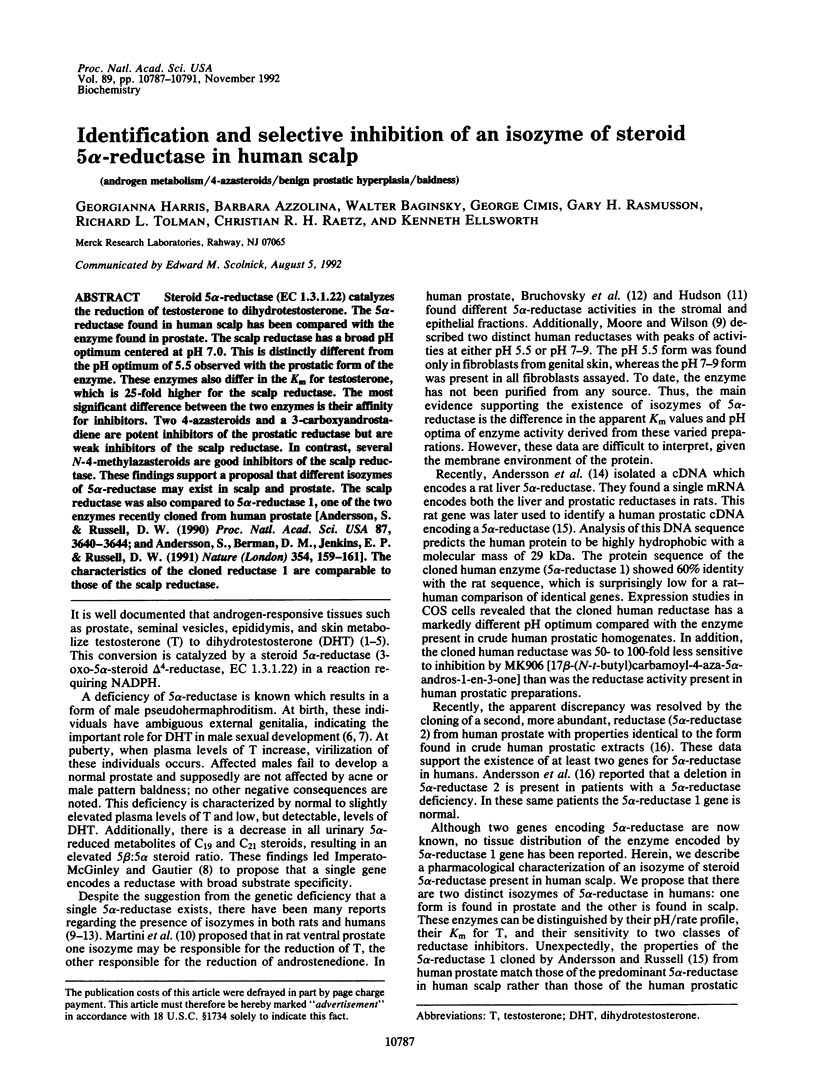
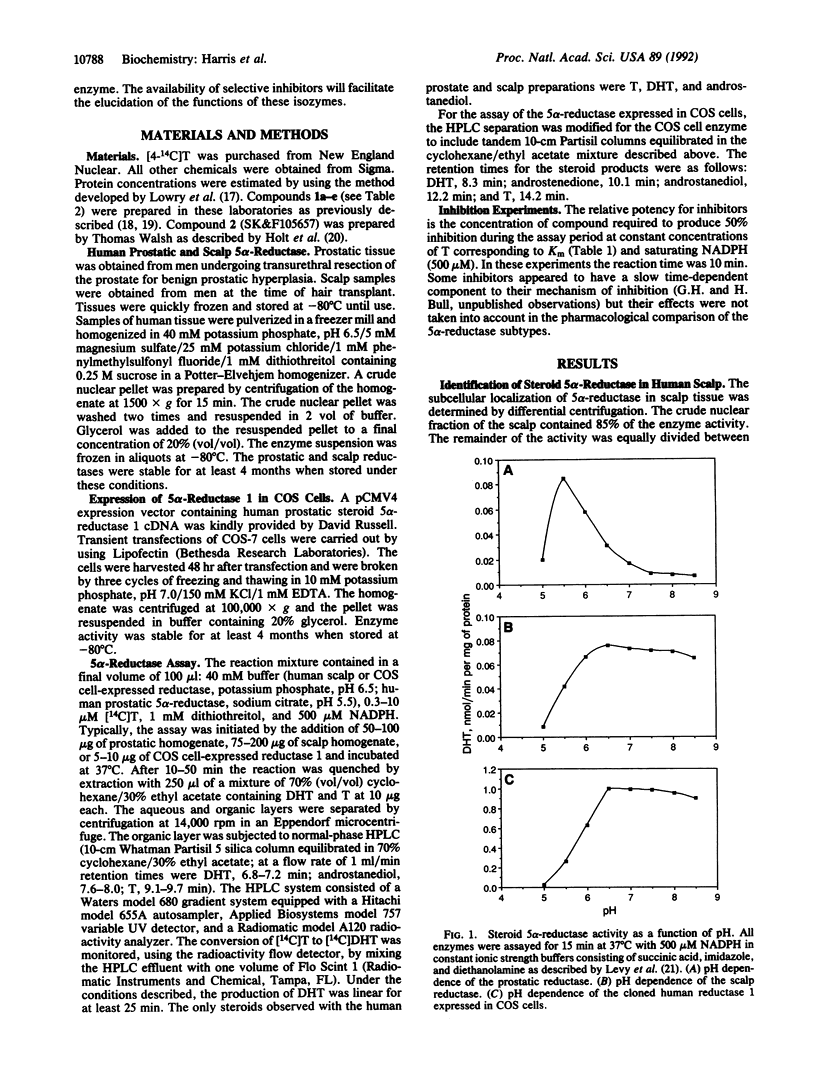
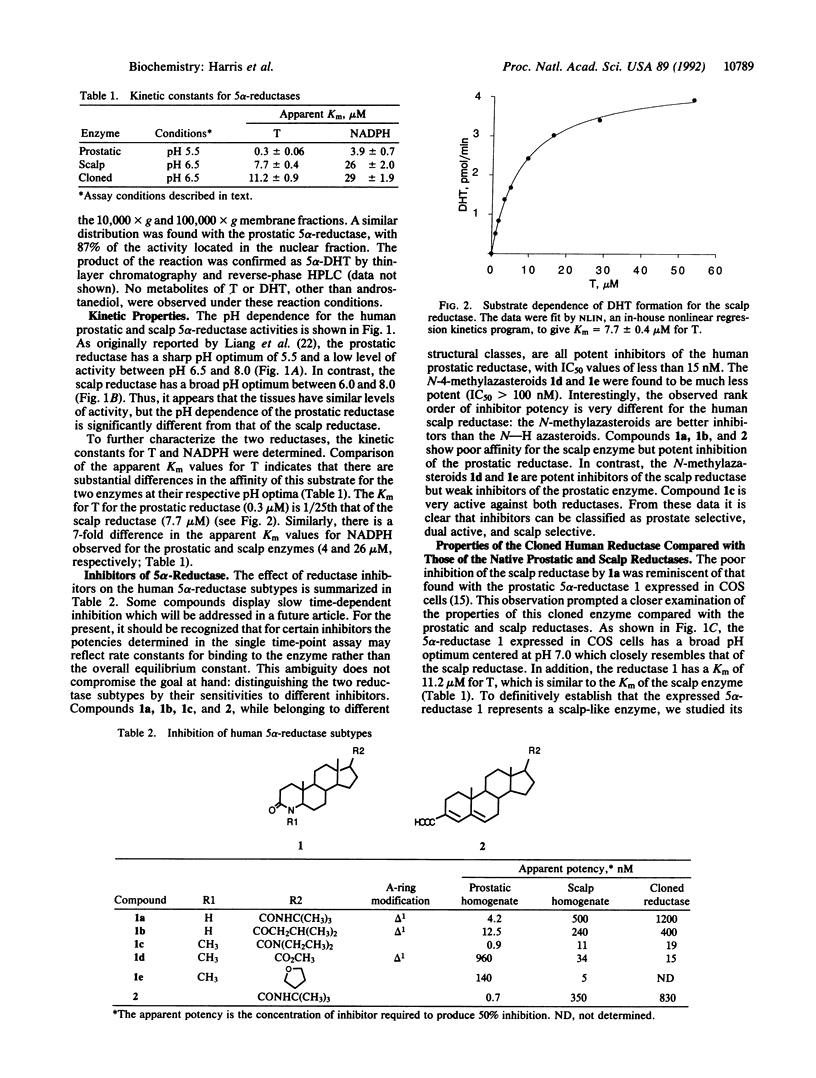
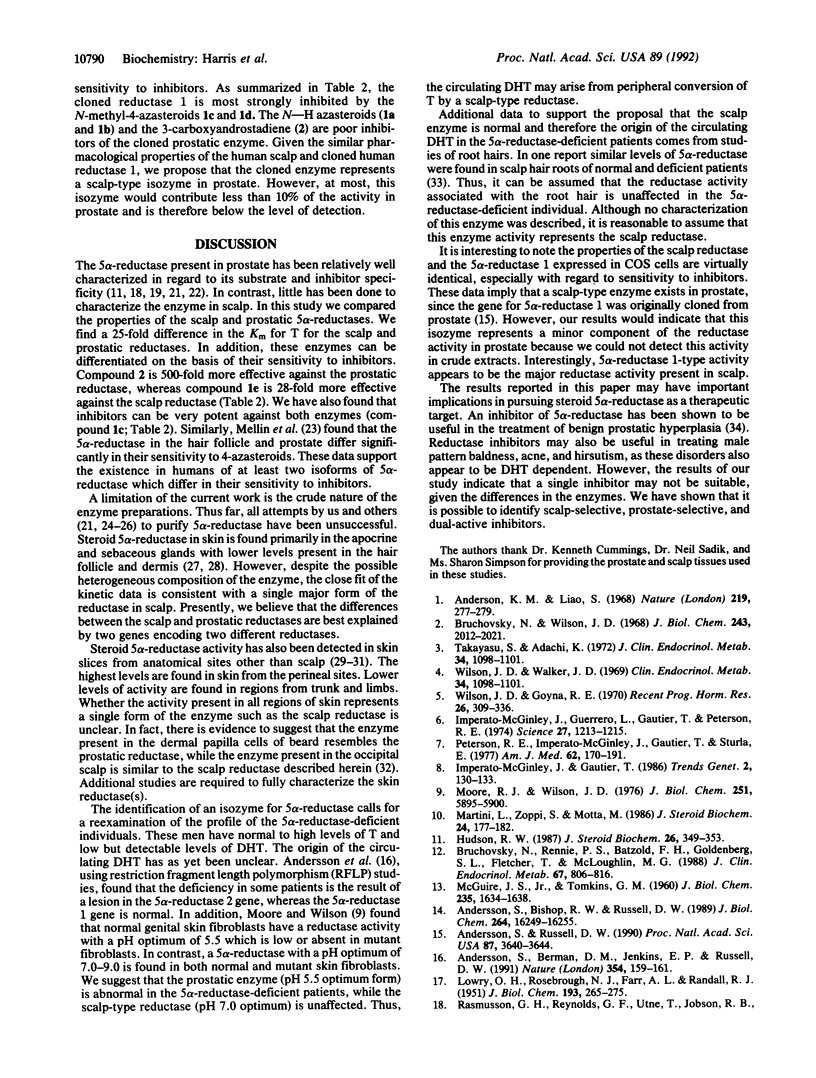
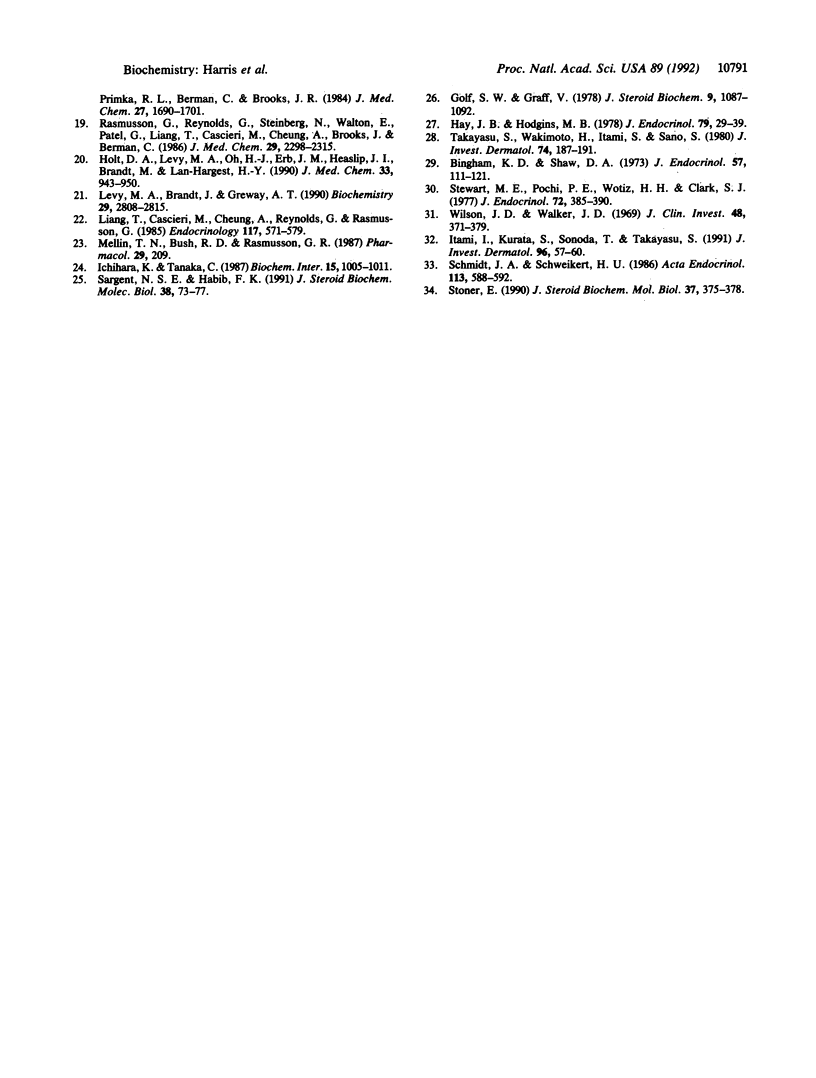
Selected References
These references are in PubMed. This may not be the complete list of references from this article.
- Anderson K. M., Liao S. Selective retention of dihydrotestosterone by prostatic nuclei. Nature. 1968 Jul 20;219(5151):277–279. doi: 10.1038/219277a0. [DOI] [PubMed] [Google Scholar]
- Andersson S., Berman D. M., Jenkins E. P., Russell D. W. Deletion of steroid 5 alpha-reductase 2 gene in male pseudohermaphroditism. Nature. 1991 Nov 14;354(6349):159–161. doi: 10.1038/354159a0. [DOI] [PMC free article] [PubMed] [Google Scholar]
- Andersson S., Bishop R. W., Russell D. W. Expression cloning and regulation of steroid 5 alpha-reductase, an enzyme essential for male sexual differentiation. J Biol Chem. 1989 Sep 25;264(27):16249–16255. [PMC free article] [PubMed] [Google Scholar]
- Andersson S., Russell D. W. Structural and biochemical properties of cloned and expressed human and rat steroid 5 alpha-reductases. Proc Natl Acad Sci U S A. 1990 May;87(10):3640–3644. doi: 10.1073/pnas.87.10.3640. [DOI] [PMC free article] [PubMed] [Google Scholar]
- Bingham K. D., Shaw D. A. The metabolism of testosterone by human male scalp skin. J Endocrinol. 1973 Apr;57(1):111–121. doi: 10.1677/joe.0.0570111. [DOI] [PubMed] [Google Scholar]
- Bruchovsky N., Rennie P. S., Batzold F. H., Goldenberg S. L., Fletcher T., McLoughlin M. G. Kinetic parameters of 5 alpha-reductase activity in stroma and epithelium of normal, hyperplastic, and carcinomatous human prostates. J Clin Endocrinol Metab. 1988 Oct;67(4):806–816. doi: 10.1210/jcem-67-4-806. [DOI] [PubMed] [Google Scholar]
- Bruchovsky N., Wilson J. D. The conversion of testosterone to 5-alpha-androstan-17-beta-ol-3-one by rat prostate in vivo and in vitro. J Biol Chem. 1968 Apr 25;243(8):2012–2021. [PubMed] [Google Scholar]
- Golf S. W., Graef V. Reconstitution of NADPH: 4-ene-3-oxosteroid-5alpha-oxidoreductase from solubilized components of rat liver microsomes. J Steroid Biochem. 1978 Nov;9(11):1087–1092. doi: 10.1016/0022-4731(78)90037-7. [DOI] [PubMed] [Google Scholar]
- Hay J. B., Hodgins M. B. Distribution of androgen metabolizing enzymes in isolated tissues of human forehead and axillary skin. J Endocrinol. 1978 Oct;79(1):29–39. doi: 10.1677/joe.0.0790029. [DOI] [PubMed] [Google Scholar]
- Holt D. A., Levy M. A., Oh H. J., Erb J. M., Heaslip J. I., Brandt M., Lan-Hargest H. Y., Metcalf B. W. Inhibition of steroid 5 alpha-reductase by unsaturated 3-carboxysteroids. J Med Chem. 1990 Mar;33(3):943–950. doi: 10.1021/jm00165a010. [DOI] [PubMed] [Google Scholar]
- Hudson R. W. Comparison of nuclear 5 alpha-reductase activities in the stromal and epithelial fractions of human prostatic tissue. J Steroid Biochem. 1987 Mar;26(3):349–353. doi: 10.1016/0022-4731(87)90100-2. [DOI] [PubMed] [Google Scholar]
- Ichihara K., Tanaka C. Some properties of progesterone 5 alpha-reductase solubilized from rat liver microsomes. Biochem Int. 1987 Nov;15(5):1005–1011. [PubMed] [Google Scholar]
- Imperato-McGinley J., Guerrero L., Gautier T., Peterson R. E. Steroid 5alpha-reductase deficiency in man: an inherited form of male pseudohermaphroditism. Science. 1974 Dec 27;186(4170):1213–1215. doi: 10.1126/science.186.4170.1213. [DOI] [PubMed] [Google Scholar]
- Itami S., Kurata S., Sonoda T., Takayasu S. Characterization of 5 alpha-reductase in cultured human dermal papilla cells from beard and occipital scalp hair. J Invest Dermatol. 1991 Jan;96(1):57–60. doi: 10.1111/1523-1747.ep12514729. [DOI] [PubMed] [Google Scholar]
- LOWRY O. H., ROSEBROUGH N. J., FARR A. L., RANDALL R. J. Protein measurement with the Folin phenol reagent. J Biol Chem. 1951 Nov;193(1):265–275. [PubMed] [Google Scholar]
- Levy M. A., Brandt M., Greway A. T. Mechanistic studies with solubilized rat liver steroid 5 alpha-reductase: elucidation of the kinetic mechanism. Biochemistry. 1990 Mar 20;29(11):2808–2815. doi: 10.1021/bi00463a025. [DOI] [PubMed] [Google Scholar]
- Liang T., Cascieri M. A., Cheung A. H., Reynolds G. F., Rasmusson G. H. Species differences in prostatic steroid 5 alpha-reductases of rat, dog, and human. Endocrinology. 1985 Aug;117(2):571–579. doi: 10.1210/endo-117-2-571. [DOI] [PubMed] [Google Scholar]
- Martini L., Zoppi S., Motta M. Studies on the possible existence of two 5 alpha-reductases in the rat prostate. J Steroid Biochem. 1986 Jan;24(1):177–182. doi: 10.1016/0022-4731(86)90048-8. [DOI] [PubMed] [Google Scholar]
- Moore R. J., Wilson J. D. Steroid 5alpha-reductase in cultured human fibroblasts. Biochemical and genetic evidence for two distinct enzyme activities. J Biol Chem. 1976 Oct 10;251(19):5895–5900. [PubMed] [Google Scholar]
- Peterson R. E., Imperato-McGinley J., Gautier T., Sturla E. Male pseudohermaphroditism due to steroid 5-alpha-reductase deficiency. Am J Med. 1977 Feb;62(2):170–191. doi: 10.1016/0002-9343(77)90313-8. [DOI] [PubMed] [Google Scholar]
- Rasmusson G. H., Reynolds G. F., Steinberg N. G., Walton E., Patel G. F., Liang T., Cascieri M. A., Cheung A. H., Brooks J. R., Berman C. Azasteroids: structure-activity relationships for inhibition of 5 alpha-reductase and of androgen receptor binding. J Med Chem. 1986 Nov;29(11):2298–2315. doi: 10.1021/jm00161a028. [DOI] [PubMed] [Google Scholar]
- Rasmusson G. H., Reynolds G. F., Utne T., Jobson R. B., Primka R. L., Berman C., Brooks J. R. Azasteroids as inhibitors of rat prostatic 5 alpha-reductase. J Med Chem. 1984 Dec;27(12):1690–1701. doi: 10.1021/jm00378a028. [DOI] [PubMed] [Google Scholar]
- Sargent N. S., Habib F. K. Partial purification of human prostatic 5 alpha-reductase (3-oxo-5 alpha-steroid:NADP+ 4-ene-oxido-reductase; EC 1.3.1.22) in a stable and active form. J Steroid Biochem Mol Biol. 1991 Jan;38(1):73–77. doi: 10.1016/0960-0760(91)90403-r. [DOI] [PubMed] [Google Scholar]
- Schmidt J. A., Schweikert H. U. Testosterone and epitestosterone metabolism of single hairs in 5 patients with 5 alpha-reductase-deficiency. Acta Endocrinol (Copenh) 1986 Dec;113(4):588–592. doi: 10.1530/acta.0.1130588. [DOI] [PubMed] [Google Scholar]
- Stewart M. E., Pochi P. E., Strauss J. S., Wotiz H. H., Clark S. J. In-vitro metabolism of [3H]testosterone by scalp and back skin: conversion of testosterone into 5alpha-androstane-3beta, 17beta-diol. J Endocrinol. 1977 Mar;72(3):385–390. doi: 10.1677/joe.0.0720385. [DOI] [PubMed] [Google Scholar]
- Stoner E. The clinical development of a 5 alpha-reductase inhibitor, finasteride. J Steroid Biochem Mol Biol. 1990 Nov 20;37(3):375–378. doi: 10.1016/0960-0760(90)90487-6. [DOI] [PubMed] [Google Scholar]
- Takayasu S., Adachi K. The conversion of testosterone to 17 -hydroxy-5 -androstan-3-one (dihydrotestosterone) by human hair follicles. J Clin Endocrinol Metab. 1972 Jun;34(6):1098–1101. doi: 10.1210/jcem-34-6-1098. [DOI] [PubMed] [Google Scholar]
- Takayasu S., Wakimoto H., Itami S., Sano S. Activity of testosterone 5 alpha-reductase in various tissues of human skin. J Invest Dermatol. 1980 Apr;74(4):187–191. doi: 10.1111/1523-1747.ep12541698. [DOI] [PubMed] [Google Scholar]
- Wilson J. D., Gloyna R. E. The intranuclear metabolism of testosterone in the accessory organs of reproduction. Recent Prog Horm Res. 1970;26:309–336. doi: 10.1016/b978-0-12-571126-5.50012-1. [DOI] [PubMed] [Google Scholar]
- Wilson J. D., Walker J. D. The conversion of testosterone to 5 alpha-androstan-17 beta-ol-3-one (dihydrotestosterone) by skin slices of man. J Clin Invest. 1969 Feb;48(2):371–379. doi: 10.1172/JCI105994. [DOI] [PMC free article] [PubMed] [Google Scholar]


